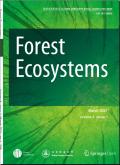Plant functional trait diversity and structural diversity co-underpin ecosystem multifunctionality in subtropical forests
Abstract
Tree species diversity is assumed to be an important component in managing forest ecosystems because of effects on multiple functions or ecosystem multifunctionality. However, the importance of tree diversity in determining multifunctionality in structurally complex subtropical forests relative to other regulators (e.g., soil microbial diversity, stand structure, and environmental conditions) remains uncertain. In this study, effects of aboveground (species richness and functional and structural diversity) and belowground (bacterial and fungal diversity) biodiversity, functional composition (community-weighted means of species traits), stand structure (diameter at breast height and stand density), and soil factors (pH and bulk density) on multifunctionality (including biomass production, carbon stock, and nutrient cycling) were examined along a tree diversity gradient in subtropical forests. The community-weighted mean of tree maximum height was the best predictor of ecosystem multifunctionality. Functional diversity explained a higher proportion of the variation in multifunctionality than that of species richness and fungal diversity. Stand structure -played an important role in modulating the effects of tree diversity on multifunctionality. The work highlights that species composition and maximizing forest structural complexity are effective strategies to increase forest multifunctionality while also conserving biodiversity in the management of multifunctional forests under global environmental changes.

 求助内容:
求助内容: 应助结果提醒方式:
应助结果提醒方式:


